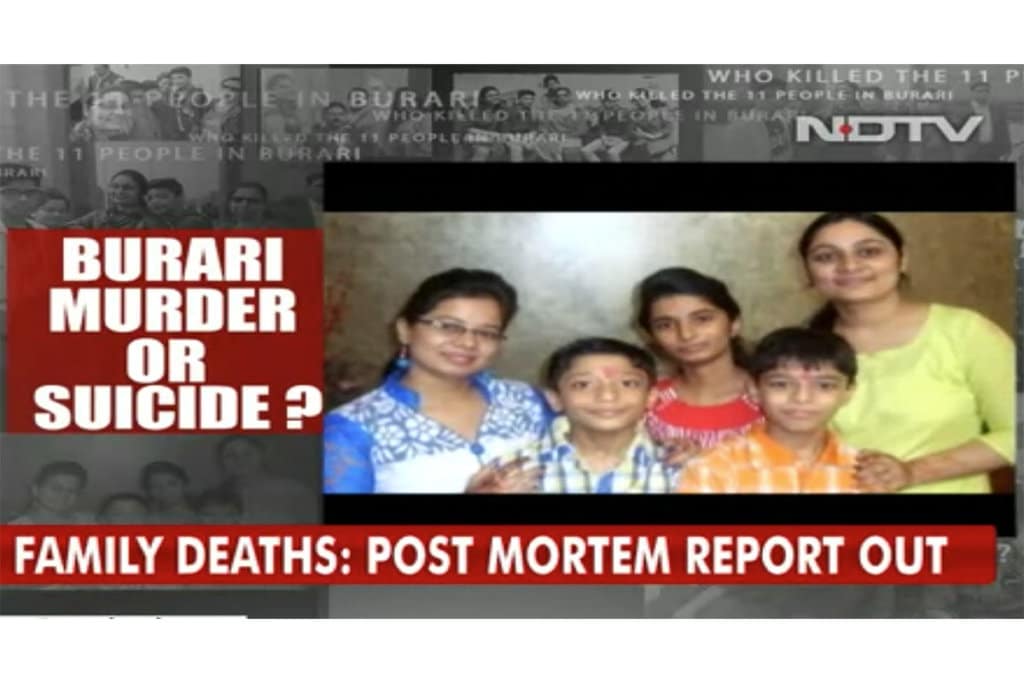Police are investigating the mysterious deaths of 11 members of a deeply religious New Delhi family, 10 of whom were found bound and hanging in their home with handwritten notes detailing a mystical suicide ritual.
An 11th family member, a 77-year-old woman, was found dead in an adjacent room. The bodies were discovered on Sunday.
Senior police official Alok Kumar said Tuesday that “on the face of it” the deaths of four male and seven female members of the Bhatia family “looks like a case of suicide.” Post-mortem reports and testimonies of relatives and neighbors are being analyzed and police probes have not ruled out murder as a cause of the deaths.
Kumar said notes found at the Bhatia residence had details about how the mouths and eyes of the family should be taped, and where each of the family members should be positioned for the ritual. “They have been maintaining a diary for the last two to three years, and in it, we found quite a graphic description which matched the condition of the bodies at the scene of the crime.”
The notes also contained a description of the family’s final meal – a stack of 20 loaves of flatbread, which were delivered to the family home earlier that evening.
Police are investigating whether the family followed a particular guru or spiritual leader. Neighbors and relatives said that the Bhatias were deeply religious, prayed three times a day and went to a nearby temple. Relatives said there was never any indication of extreme beliefs, though the family’s faith had intensified after one its members – 45-year-old Lalit – had made a miraculous recovery after a plank of plywood fell on his head more than a decade ago.
Nonetheless, the case has sent shock waves through India, where self-appointed, charismatic holy men hold huge sway, and where a number of recent cases involving rapes, abuse and deaths of followers of spiritual gurus have sparked concerns about how much power these men have.
The family was found on Sunday morning when a 79-year-old neighbor Gurcharan Singh went inside the home to ask why they had not opened their convenience store that morning and saw the 10 bodies hanging. “I saw it and came out. I couldn’t bear to look,” he said. The family’s dog, now in police custody, had been tied up on the roof, Singh told The Washington Post.
Among those who died were two 15-year-old boys, and a young woman, who according to relatives had been planning her wedding.
A police press release said that there was no evidence that the house had been ransacked – gold jewelry was found on the bodies of the women and mobile phones were found in the house. CCTV footage from the street also does not suggest that anyone entered or left the house from the main door on the night of the deaths, police said.
Samir Parekh, director of the Department of Mental Health and Behavioral Sciences at Fortis Healthcare said that though the specifics of this case were still unclear, pact suicides are usually led by a dominant family member.
“When a key family member decides that it’s time to end their life, the rest are left in a very difficult situation.” He also said that socioeconomic reasons or a fall in status could also contribute to suicide.
A number of relatives gathered outside the Bhatia family home on Monday said they did not believe that the family could have committed mass suicide.
Anju Bhat, a relative who was mourning the family outside their home on Monday said that she regularly came to visit the family, especially the 77-year-old matriarch Narayana. “This is all lies, she didn’t believe in these things,” she said, when asked about the suicide ritual. “I came here just a month ago. Whenever we saw each other, she’d bare her heart, and I’d bare mine. She had a very nice manner.”
Tiloki Nath, a 70-year-old relative, said, “This was murder for sure. One person may kill themselves, maybe two – but an entire family? Some one did this.”
Neighbors too said they found it hard to believe what had happened. “They were good people. There was nothing wrong with them,” said a 70-year-old who lives next door. “From the outside, you could never fault them. What happened inside, who knows?”
(c) 2018, The Washington Post
